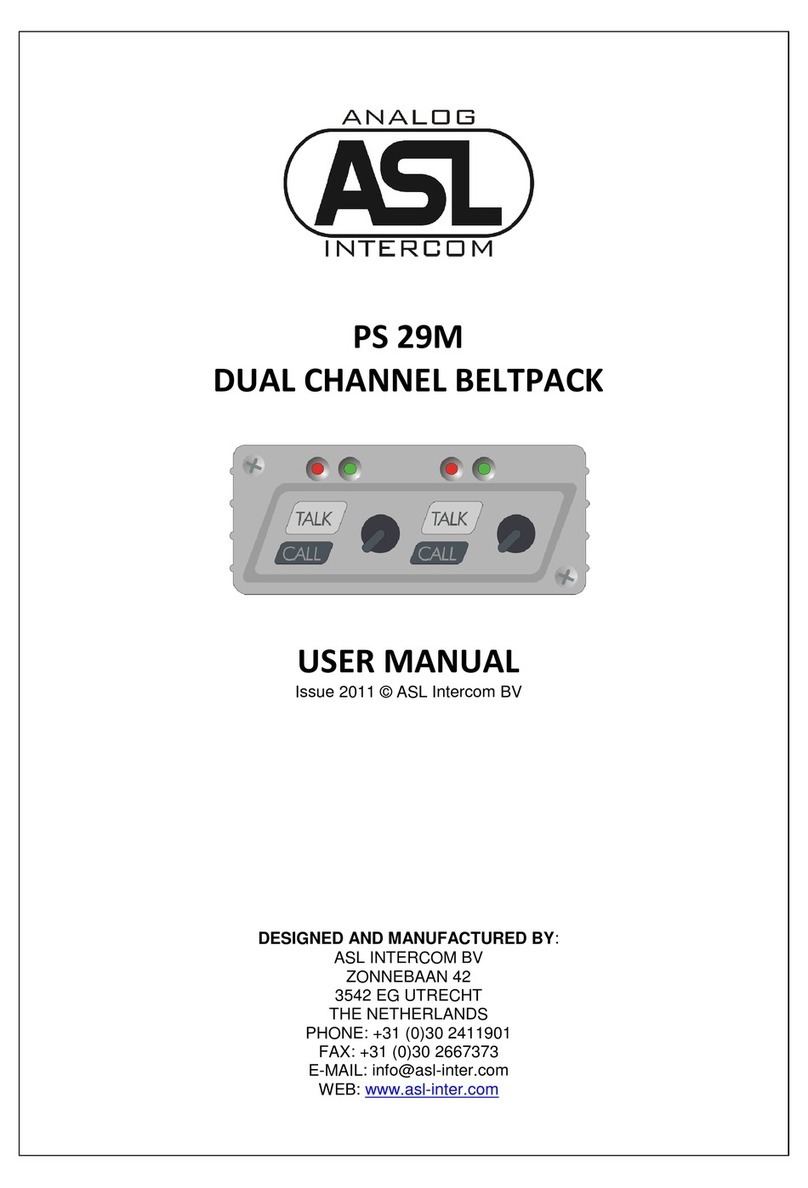
User Manual PS 630 / Issue 1 © 1994 ASL Intercom, Utrecht, Holland. 3
1.0 GENERAL DESCRIPTION
The PS 630 is a six channel speaker station designed Special attention has been paid to the intelligibility of
for use in both portable and fixed intercom systems. speech. By applying low noise/high speed opamps, a
It incorporates a loudspeaker and a gooseneck speech presence filter and a specially developed high
microphone and provides full duplex communications power bridged headphone amplifier, communication is
within an ASL intercom system. The PS 630 RM model very comfortable even in environments with high back-
has a small built-in electret microphone. ground noise level. There is a separate amplifier for
Each channel has a Volume (listen level) control, a
Talk and Call button with LED indicators, channel The unique ASL CALL system provides both a flashing
on/off switch and a two-stage sidetone trimmer. A red LED and a very distinctive and characteristic
master volume controls the total speaker/headset sound signal. Smooth operation is guaranteed with the
volume. CALL button. Only a slight touch makes the red LED
The unit is equiped with a limiter for the gooseneck activate the CALL sound signal. The volume of the
microphone, allowing the user to speak close into the sound signal (buzzer) can be adjusted at the front
microphone without giving rise to overload and panel.
distortion. Loudspeaker dimming is automatic when
the microphone is active. Private conversation may be The preamplified microphone signal is electronically
carried out via the headset connector with a headset balanced available at a 3 pin male XLR. This signal can
or telephone handset. When a headset is connected,
both gooseneck microphone and speaker are disabled
automatically.
As an option, a XLR-6 headset connector can be fitted
for binaural use of the headset. By setting internally
mounted jumpers, each of the 6 channels can be
assigned to either the left or the right headset can, or
to both headset cans.
An electronically balanced input allows volume
controlled monitoring of an audio signal. This is for
local use only, it will not appear on the intercomlines.
the loudspeaker.
flash, whilst holding the button for two seconds will
be sent to paging systems.
Fully electronic switching increases reliability and
allows for :
-'soft' microphone ON switching, latched or
momentary
-remote Mic Mute facility.
-automatic speaker attenuation (adjustable), when
the microphone is activated.
2.0 UNPACKING
The shipping carton contains the parts listed below: After unpacking the unit please inspect for any
*The PS 630 physical damage to the unit, and retain the shipping
*User manual carton and relevant packing materials for use should
*19" rackmount flares the unit need returning.
If any are missing, contact your dealer. If any damage has occured, please notify your dealer
ASL has taken great care to ensure this product Please also refer to the guarantee section of this
reaches you in flawless condition. manual.
immediately so that a written claim can be initiated.
3.0 INSTALLATION
This PS 630 will form part of an existing or new and 1 shield only. Connect the system intercom cables
intercom system, and connection to it is into the LINE connector sockets on the rear panel.
straightforward. There are no separate power Finally, when private conversation is desired, connect
connections or batteries to install, as the necessary the listening headset plug into the HEADSET
DC voltages are derived from the intercom master connector on the front panel.
station or power supply, via the intercom connection
cable. The PS 630 is fully protected against mis wiring
To connect the PS 630 onto the intercom system, use cables.
professional flexible microphone cable with 2 wires
(reverse power) or short circuit in the interconnect




























